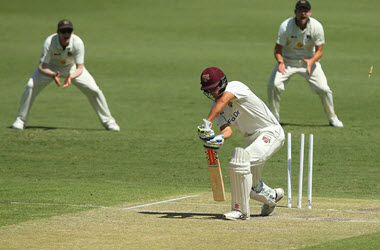The 10 Ways of Getting Out in Cricket
There are 10 different ways a batsman can be out in cricket. The outs are also known as methods of dismissal, as the bowling team can appeal to the umpire so they can judge if the batsman is out or not. Here are the 10 ways, from most common to le4ast common, a batsman can make an out.
1. Caught – If a member of the bowling team catches a ball before hitting the ground, the batsman is out. This is the most common out in cricket. There are typical fly outs and sensational and diving ones, but they all equal one thing and that is an out.
2. Bowled – If the batsman does not protect his stumps and one becomes dislodged they are out. One or both balls have to hit the stumps for the out to occur.

3. Leg Before Wicket – This out is simply referred to as an LBW where if the ball hits the batsman and would have likely hit the stumps it is an out. The bowling team has to field an appeal to the umpire for the out to occur if they believe the stumps would have been hit if not been hit by the batsman’s body first. This type of out has conditions, as the ball has to bounce outside or in line with the stumps, the hit batsman has to be in the line of the stumps, the ball cannot pitch outside the stumps, and the batsman has not shot. Also, for this out to occur the ball cannot hit the glove or bat of the batsman.
4. Run Out – If the batsman cannot make his ground before the fielding team dislodges the ball they are out. Typically, the wicketkeeper and bowler are involved in run-outs where they get the ball from another fielder and hitting the bails off while the ball is still in their hands.
5. Stumped – The batsman can go outside of the batting crease when attempting to make a shot and they miss the ball completely, and the wicketkeeper moves the bails before the batsman gets to their ground than they are out. A stumping out will typically happen off-spin bowling considering the wicketkeeper will have to be standing next to the stumps.
6. Hit Wicket – The hit wicket does not happen very often, and it happens a batsman hits and knocks over a wicket with either the bad or their body. You will usually see a hit wicket out when a batsman either hits the wicket with a wilder swing or steps backwards dislodging the wicket. If a batsman’s helmet falls off and hits the stumps, it is also a hit wicket out.

7. Handled the Ball – If a bowled ball hits the hand of the batsman and does not get permission to do so from the fielding team, they are out. However, in cricket etiquette, this does not often happen, as the fielding team will not lodge an appeal with the umpire unless the handles ball affects the play.
8. Obstructing Field of Play – If a batsman gets in the way of a fielder, they can be out. This is a little dicey in the rules, as there are collisions that are common with the batsman running and the fielder trying to get the ball. If the collision is deemed an intentional one, they will be out.
9. Hitting the Ball Twice – If the batsman hit the ball twice with the bat or their body they will be out, but the 2nd hit has to be an intentional one. If the 2nd hit from the batsman is intentional and it keeps the ball from striking the stumps that is ok, and there are not out. An out for hitting the ball twice has never occurred in international cricket.
10. Timed Out – If a batsman does not come to the crease after three minutes of the previous batters out they are timed out. Again, rare air here, as a time out has never happened in international cricket.

